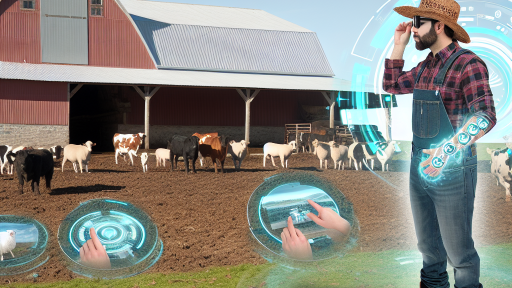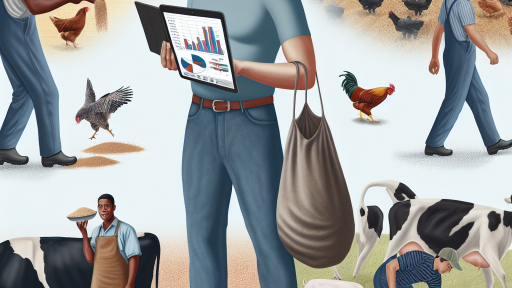Understanding the Basics of Genetic Traits in Breeding
Defining Genetic Traits
Genetic traits are characteristics inherited from parent organisms.
These traits influence a variety of features in plants and animals.
For example, traits can determine color, size, and productivity.
Understanding these traits helps breeders make informed decisions.
The Role of Heredity
Heredity refers to the transmission of genetic traits from parents to offspring.
This process is governed by the principles of genetics.
Key mechanisms include dominant and recessive traits.
Dominant traits often express themselves over recessive ones.
As a result, knowing these relationships is essential for successful breeding.
Importance of Environmental Factors
Environmental factors also play a crucial role in expressing genetic traits.
For instance, soil quality and weather conditions can affect plant growth.
Similarly, animal health and habitat impact their genetic expression.
Therefore, breeders must consider both genetics and environment together.
Evaluating Key Traits in Breeding
Breeding programs focus on specific traits to achieve desired outcomes.
Common traits to evaluate include disease resistance, yield potential, and growth rate.
Transform Your Agribusiness
Unlock your farm's potential with expert advice tailored to your needs. Get actionable steps that drive real results.
Get StartedAdditionally, breeders assess traits like adaptability and nutrient efficiency.
These evaluations lead to better selection of parent organisms.
Genetic Diversity and Its Benefits
Maintaining genetic diversity is vital in breeding programs.
Diverse genetic backgrounds strengthen resilience against diseases.
Moreover, they enhance adaptability to changing environments.
Consequently, breeders should aim to preserve and utilize genetic variability.
Advancements in Genetic Research
Recent advancements in genetic research enhance breeding methods.
Technologies such as gene editing and marker-assisted selection are prominent.
These tools enable more precise and efficient trait selection.
Furthermore, they help in shortening the breeding cycle.
As a result, modern breeding strategies become both faster and more effective.
The Role of Dominant and Recessive Traits in Agriculture
Understanding Genetic Traits
Genetic traits play a vital role in agriculture.
They influence everything from crop yield to disease resistance.
Diving into genetics helps farmers make informed breeding decisions.
Dominant Traits in Agriculture
Dominant traits are expressed even with one copy of the allele present.
Farmers often prefer these traits for their reliability.
Common examples include drought tolerance and pest resistance.
These traits can improve overall crop performance significantly.
Recessive Traits in Agriculture
Recessive traits require two copies of the allele for expression.
While less frequently chosen, they hold specific advantages.
For instance, some recessive traits provide unique flavors in crops.
After careful evaluation, farmers may incorporate these traits into breeding.
Combining Dominant and Recessive Traits
A strategic blend of traits can optimize agricultural outcomes.
Farmers can create hybrids that leverage both types of traits.
Showcase Your Farming Business
Publish your professional farming services profile on our blog for a one-time fee of $200 and reach a dedicated audience of farmers and agribusiness owners.
Publish Your ProfileThis approach balances resilience with unique characteristics.
As a result, crops become more adaptable to changing environments.
Assessing Trait Expression
It’s crucial to assess the expression of traits in offspring.
Farmers can utilize genetic testing to evaluate potential outcomes.
This testing ensures that breeding aligns with their agricultural goals.
Utilizing Genetic Traits for Success
Utilizing dominant and recessive traits is essential in modern agriculture.
This approach fosters greater yields and improves sustainability.
Farmers who understand these concepts position themselves for success.
Identifying Key Traits for Livestock Breeding Success
Understanding Genetic Traits
Genetic traits play a critical role in livestock breeding success.
They influence growth rate, reproduction, and overall health.
Breeders must identify traits that align with their goals.
Targeted breeding enhances desirable characteristics in livestock.
Performance Traits
Performance traits are essential for evaluating livestock potential.
These traits include weight gain, feed efficiency, and milk production.
Evaluating these traits helps in selecting superior breeding stock.
Moreover, genetic performance evaluations provide valuable insights.
Growth Rate
Growth rate measures how quickly livestock reach market weight.
Higher growth rates result in shorter timeframes for production.
This trait is vital in beef and pork production systems.
Feed Efficiency
Feed efficiency assesses the amount of feed required for growth.
More efficient animals require less feed for the same growth rate.
Improving feed efficiency can significantly reduce production costs.
Reproductive Traits
Reproductive traits directly affect herd productivity.
These include fertility rates, calving ease, and litter size.
High reproductive performance leads to increased herd numbers.
Breeding for these traits should be a priority for success.
Fertility Rates
Fertility rates indicate how often livestock conceive successfully.
Improving fertility reduces downtime between breeding cycles.
This trait is crucial for maintaining herd productivity levels.
Calving Ease
Calving ease affects both the cow and the calf’s health.
Breeders should prioritize animals that calve with less difficulty.
Minimizing complications supports healthier livestock overall.
Health and Longevity Traits
Health traits are critical for long-term breeding success.
These traits include disease resistance and longevity of production.
Animals that are healthier contribute to lower veterinary costs.
Additionally, longer-lived animals provide more offspring over time.
Disease Resistance
Disease resistance can significantly impact herd productivity.
Animals that resist common diseases require less medical intervention.
This leads to a more sustainable and cost-effective operation.
Longevity
Longevity refers to the productive lifespan of livestock.
Showcase Your Farming Business
Publish your professional farming services profile on our blog for a one-time fee of $200 and reach a dedicated audience of farmers and agribusiness owners.
Publish Your ProfileChoosing for longevity can improve overall profitability.
Animals that remain productive longer provide greater returns.
Aesthetic and Conformation Traits
Aesthetic traits may not seem essential, yet they influence market value.
Traits such as body structure and muscle development affect sales.
Well-conformed animals usually fetch higher prices at market.
Breeders should also assess these traits alongside performance.
Find Out More: Revolutionary Livestock Management Tools Every Farmer Should Know
Genetic Variability and Its Importance for Crop Diversity
Understanding Genetic Variability
Genetic variability refers to the diversity in genes within a plant species.
This diversity plays a vital role in crop adaptation.
Plants with varied genetics can better withstand environmental changes.
Moreover, diverse genetic traits contribute to higher resilience against diseases.
Enhancing Crop Resilience
Breeding for genetic variability enhances crop performance.
Resilient crops can thrive in adverse conditions like drought or flood.
Additionally, they can effectively combat pests and pathogens.
Increasing resilience also supports sustainable farming practices.
Promoting Crop Diversity in Agriculture
Crop diversity enhances food security globally.
It allows for a range of crops suited to various climates and soils.
A diverse crop landscape protects against total crop failures.
It also encourages a more stable ecosystem for agricultural practices.
Conserving Genetic Resources
Conserving genetic resources ensures future food supply stability.
This practice involves preserving rare and endangered crop varieties.
Each variety carries unique traits beneficial in changing environments.
Consequently, genetic conservation aids in long-term agricultural sustainability.
Explore Further: The Future of Livestock Farming: Embracing Automation and Precision Care
The Impact of Environmental Factors on Genetic Traits Expression
Overview of Genetic Expression
Genetic traits express themselves based on a variety of factors.
These factors include the environment, nutrition, and genetics.
Understanding this interaction is crucial for successful breeding.
Role of Environment
The environment significantly influences genetic expression.
Temperature, soil quality, and humidity can alter traits.
For instance, higher temperatures may stress plants, affecting yield.
Similarly, soil nutrients directly impact growth characteristics.
Nutrition’s Influence
Nutritional elements are vital for optimal trait development.
Plants require balanced nutrients for proper growth and health.
Deficiencies can hinder the expression of desired traits.
Thus, monitoring soil and plant nutrition is essential.
Examples of Trait Variation
Height is a trait that commonly varies depending on environmental factors.
Plants may grow taller in nutrient-rich soils compared to depleted ones.
Flower color can also change due to pH levels in the soil.
These variations present challenges and opportunities in breeding.
Technological Advances in Monitoring
Advancements in technology aid in monitoring environmental conditions.
Showcase Your Farming Business
Publish your professional farming services profile on our blog for a one-time fee of $200 and reach a dedicated audience of farmers and agribusiness owners.
Publish Your ProfileFor example, sensors can track soil moisture levels and nutrient content.
Data collected can inform breeding decisions effectively.
This integration of technology enhances breeding success rates.
Importance of Environmental Factors
In summary, environmental factors play a critical role in genetic traits expression.
Understanding these factors helps in making more informed breeding choices.
Future breeding programs must consider the intricate interplay between genetics and the environment.
Delve into the Subject: What Every Cattle Farmer Should Know About Disease Prevention

Techniques for Selecting and Propagating Desired Traits
Understanding Genetic Variation
Genetic variation plays a vital role in breeding programs.
It allows selection for desirable traits within a population.
Furthermore, understanding the source of variation is crucial.
This knowledge helps breeders make informed decisions.
Identifying Desirable Traits
Start by identifying traits that benefit the breeding program.
Factors like disease resistance and yield potential are essential.
Moreover, consider traits related to climate adaptation.
For instance, drought tolerance can significantly impact success.
Establishing Selection Criteria
Once traits are identified, establish clear selection criteria.
Criteria should be specific, measurable, and achievable.
Additionally, involve stakeholders in developing these criteria.
This engagement fosters broader support for breeding objectives.
Using Selective Breeding Techniques
Selective breeding is a traditional method for trait enhancement.
This technique involves choosing parent plants with desirable traits.
Subsequently, crossbreed them to produce offspring with preferred qualities.
Furthermore, pay attention to genetic purity during this process.
Implementing Marker-Assisted Selection
Marker-assisted selection speeds up the breeding process.
This technique utilizes molecular markers linked to desirable traits.
By testing for these markers, breeders can efficiently select candidates.
As a result, they increase the likelihood of desired outcomes.
Incorporating Genomic Selection
Genomic selection enhances the accuracy of trait prediction.
This modern technique uses genome-wide markers to predict performance.
It allows breeders to make quicker, data-driven decisions.
Therefore, integrating this technology is increasingly beneficial in breeding.
Monitoring and Evaluating Progress
Regular monitoring is essential to evaluate the effectiveness of selection methods.
Keep detailed records of trait performance in progeny.
This enables ongoing adjustments to breeding strategies as needed.
Ultimately, responsive management ensures continuous improvement.
Collaboration and Knowledge Sharing
Collaboration among breeders can enhance knowledge and resource sharing.
Joint research initiatives promote innovative strategies in trait selection.
Additionally, participating in breeding networks provides new insights.
Building a community around breeding practices elevates outcomes.
Gain More Insights: Top Livestock Management Tips from Expert Farmers
Showcase Your Farming Business
Publish your professional farming services profile on our blog for a one-time fee of $200 and reach a dedicated audience of farmers and agribusiness owners.
Publish Your ProfileEthical Considerations in Genetic Modification and Breeding
Understanding Ethical Implications
Genetic modification raises significant ethical questions.
One must consider the welfare of the organisms involved.
Moreover, the potential for unintended consequences poses risks.
Ethical guidelines should govern genetic practices.
Societal Impact
Genetic modification affects society in profound ways.
It can lead to food security and economic benefits.
However, it may also create dependency on specific technologies.
Therefore, society must engage in discussions about its implications.
Environmental Considerations
The impact of genetic modification on ecosystems requires attention.
Modified organisms may outcompete native species.
Additionally, changes in biodiversity can result from genetic practices.
Environmental assessments should accompany breeding programs.
Transparency and Public Involvement
Transparency in genetic research fosters trust.
Public involvement can lead to better decision-making.
Open communication about risks and benefits is crucial.
Engaging the public can alleviate fears surrounding genetic modification.
Regulatory Frameworks
A comprehensive regulatory framework is necessary for genetic modification.
Governments must enforce safety standards for modified organisms.
Additionally, international cooperation can facilitate best practices.
Regulation must evolve alongside advancements in technology.
Case Studies: Successful Breeding Programs Leveraging Key Traits
Introduction to Successful Breeding
Successful breeding programs emphasize specific genetic traits.
These traits significantly impact animal performance and productivity.
Moreover, they enhance resilience and adaptability in various environments.
Highlighting the Example of Blue Sky Farms
Blue Sky Farms implemented a breeding program focused on disease resistance.
Their primary goal was to ensure livestock longevity.
Initially, the program utilized genomic selection techniques.
This approach significantly improved disease resistance traits.
Consequently, overall herd health and productivity soared quickly.
Results at Blue Sky Farms
Over five years, infectious disease rates in their herd dropped by 40%.
Furthermore, average milk production increased by 15%.
These improvements validate the importance of targeted breeding strategies.
Case Study: Green Leaf Livestock Company
Green Leaf Livestock Company concentrated on growth rates.
They analyzed genetic data to select for fast-growing breeds.
This strategy led to substantial improvements in production rates.
Achievements of Green Leaf Livestock Company
In just three years, they recorded a 30% increase in weight gain.
Furthermore, feed efficiency improved, reducing overall costs.
Such results underline the effectiveness of genetic trait selection.
Innovative Practices at Sunshine Poultry
Sunshine Poultry prioritized egg production traits in their breeding program.
The company adopted cutting-edge molecular techniques.
This enabled the identification of superior genetic lines quickly.
Showcase Your Farming Business
Publish your professional farming services profile on our blog for a one-time fee of $200 and reach a dedicated audience of farmers and agribusiness owners.
Publish Your ProfileImpacts of Sunshine Poultry’s Innovations
As a result, egg yield per hen increased by 25% within two years.
Additionally, the quality of eggs significantly improved, enhancing marketability.
These successes illustrate how targeted approaches can optimize production.
Summary of Key Takeaways
Successful breeding programs leverage specific genetic traits effectively.
These case studies highlight significant improvements in productivity.
Moreover, they emphasize the need for targeted breeding strategies.
Each example demonstrates the potential of integrating innovative techniques.
Focused breeding efforts can lead to remarkable outcomes.
Additional Resources
Preserving Genetic Diversity Gives Wild Populations Their Best …
Genomic Analysis, Progress and Future Perspectives in Dairy Cattle …




